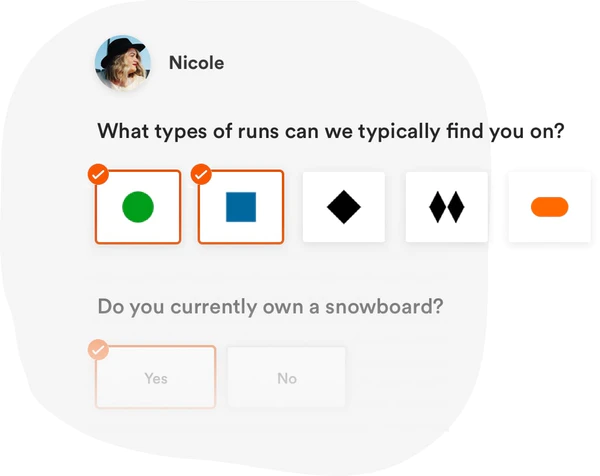
Imagine this: you are taking up a new hobby. Say, golf. You’ve played a few times before, but you don’t know that much beyond that. Now you want to get serious about it.
But just as your excitement builds, a wave of anxiety hits. Your palms sweat and your head spins. What kind of golf clubs do I need? How many golf balls should I buy? Do I have to wear special golfers’ pants?
A decade ago, you might drive over to your local Golf Galaxy and stare blankly at an Assistant Pro as he rattled on about Calloway wedges and Titleist Pro V1s. But this is 2020. Not only do we have Covid-19, but we have the internet.
You start searching Google for answers, but that only begets further questions. Why are some shafts made of granite and others made of steel? Which brand sells the best driver for my type of swing? Should I purchase a 60 degree wedge? Websites give some answers, but none of them give you confidence (plus, it takes a long time to read).
If only there was someone you could just talk to. Someone who knew a lot about golf and who also knew a lot about you.
What’s the problem?
Curated is solving a simple but important problem: people want to buy things online, but for big-ticket items they still want advice from a salesperson. It almost seems silly to buy a pair of skis online because there are so many questions and considerations.
Sometimes content on the internet can answer these questions. But sometimes it can’t. Sometimes there’s a “but in my situation…” that needs the human touch. And that’s what Curated is for.
Curated pairs customers who want to buy something expensive with experts who know about those categories. Customers can speak with experts via email, video chat or text message.
For example, say you take up skiing and need to purchase a bunch of ski gear. Through Curated, you could talk to a lifetime skier or semi-pro athlete who could answer questions and suggest the best gear for your situation. Curated experts are vetted by both Curated employees and the existing expert community to ensure their expertise.
Experts are athletes and enthusiasts. Most experts have another job, but Curated gives them an opportunity to make a second income giving advice to people about something they love to do.
The Napkin Math
Here’s how all the pieces fit together. Curated isn’t a typical two-sided marketplace between customers and suppliers. Instead, it’s a three-sided marketplace with customers, suppliers and experts.
Curated uses the classic retail model: they purchase inventory from suppliers at wholesale prices and sell at retail prices. Experts get paid by Curated: they earn a commission on all sales and also receive an hourly wage. Customers get free advice and pay the standard retail price for the items they buy (Curated price matches most online retailers). Additionally, customers can give tips to the experts if they liked their advice.
To estimate their unit economics, let’s use skis as an example. We can assume the average order value of $800, so that’s their revenue per transaction. We don’t know Curated’s margins, but sporting goods gross margins average 38.6% so we can safely assume something similar for Curated. Let’s peg it at 40%, which would mean they pay $480 for the inventory.
The next expense is the experts. Again, we don’t know the details of how Curated experts get paid. All we know is that it’s a combination of an hourly rate and a percent commission. However, according to a job posting, the average expert works between 10 - 20 hours a week and collects $300 - $500 every two weeks. This averages out to $12.50 - $15.00 per hour. REI Sales Specialists (a comparable job) make $14.67 per hour so it passes the gut check.
If we round up to $15 per hour and estimate that it takes 3 hours per transaction, that's an additional $45 in expenses for Curated experts. This brings us to $525 in costs for the inventory plus the experts.
The best part about Curated’s model is it naturally tends towards a high AOV, so shipping doesn’t take up too much of the total. However, Curated is shipping large items. The cost isn’t inconsequential. It’s estimated that skis can be shipped for $40. If we add that to the other expenses, we get $565 in COGS, leaving $235 in gross profit per order.
One of the toughest parts of this model is that the purchases aren’t very likely to be recurring. It’s rare that anyone buys two different pairs of skis. And if they do, they likely won’t need an expert for the second pair -- they will be an expert themselves. So that $235 in gross profit per order is probably pretty close to their customer lifetime value (LTV).
Now, can they reliably acquire customers for less than $235? The entire business hinges on the answer. On one hand, $235 buys you a lot of Facebook ads or SEO-optimized articles. On the other hand, eCommerce is extremely competitive.
Is it going to work?
I have two main concerns with Curated. First is that this kind of platform — an advice-driven eCommerce platform — shouldn’t be horizontal, spread across a number of categories. Instead, it should be industry-specific. Why? One of the biggest costs Curated is going to be marketing. And one of the best ways to reduce marketing spend is to have an existing audience so that you don’t have to pay to reach your audience. If you try to be everything, it can be easy to be nothing.
The other concern is that Curated is solving the wrong customer problem. On one hand, returns cost eCommerce merchants as much as 15% - 30% of sales. Curated almost certainly reduces this by helping the customer choose the right item the first time. However, advice isn’t the only thing that customers gain by going to a retail store. Trying on clothes and testing sporting equipment is still a pain point that can’t be solved with eCommerce. Of course, some people won’t mind. But it just limits the market that Curated can attack.
With all that said, a lot of times the success of early startups is determined by the resilience of their founding team. Eddie Vivas is Curated’s co-founder and CEO and was previous Head of Product at LinkedIn Talent Solutions (which is where LinkedIn now derives most of its revenue). I haven’t personally met him but his background suggests he’s more than qualified. Curated also has $27 million in fresh funding from Forerunner Ventures to recruit top talent to help them grow.
There’s certainly a lot of risk to the idea but it’s worth a shot.
The Only Subscription
You Need to
Stay at the
Edge of AI
The essential toolkit for those shaping the future
"This might be the best value you
can get from an AI subscription."
- Jay S.
Join 100,000+ leaders, builders, and innovators

Email address
Already have an account? Sign in
What is included in a subscription?
Daily insights from AI pioneers + early access to powerful AI tools











Comments
Don't have an account? Sign up!
Interesting Article! But aren't the expert costs in your calculation underestimated, as not 100% of customers buy an article after getting consulted by the expert? Therefore after adjusting for a conversion rate, you would get significantly higher costs per expert?